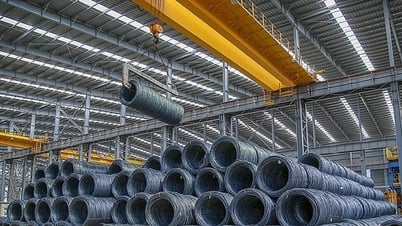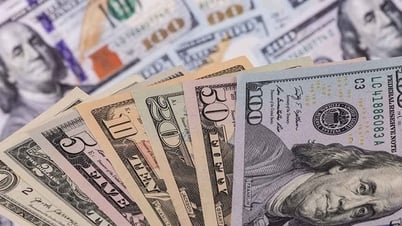Real estate is the "King" of collateral assets.
In the banking credit ecosystem, real estate has long been the most popular and preferred type of collateral. It is no coincidence that banks favor real estate – a type of asset that is highly stable, difficult to damage, difficult to lose value and even tends to increase in value over time.
With that characteristic, real estate is considered a "wall" to prevent risks for loans, when the value of the collateral is often valued higher than the principal balance, helping banks maintain a safe buffer in credit activities.
Surveys from financial reports of many banks show that real estate accounts for an overwhelming proportion in the mortgage portfolio, showing the system's great dependence on the real estate market.
At Agribank - one of the "giants" in the banking industry, the total value of mortgaged and pledged assets of customers in 2024 has reached 3.19 million billion VND, an increase of more than 9% compared to 2023.
Of which, real estate alone accounted for 2.92 trillion VND, an increase of more than 10% compared to the end of last year, far surpassing other types of assets such as movable property (190,000 billion VND) or valuable papers (54,663 billion VND).
Not only Agribank, other big names such as BIDV or VietinBank also own a huge portfolio of mortgaged assets, mainly real estate. Specifically, at the end of 2024, BIDV recorded a total value of assets, valuable papers mortgaged, pledged, and discounted up to 3.32 million billion VND, while VietinBank reached nearly 3.29 million billion VND - showing a remarkable similarity between the state-owned "giants" in credit strategies closely linked to the real estate market.
However, behind that seemingly solid picture are cracks that are quietly spreading. According to SSI Research, in the first quarter of 2025, bad debt at banks has not improved significantly, especially for loans related to real estate projects that have not completed legal procedures - which are "clogged" in both liquidity and investor confidence.
As a result, a portion of home loans associated with these projects have been reclassified as bad debt, increasing the bad debt ratio at a number of joint stock commercial banks.
Not stopping there, the state-owned commercial banking sector is also under pressure from restructuring loans for businesses operating in the construction materials sector - an auxiliary industry that is suffering a chain reaction from real estate.
The average bad debt ratio at 24 banks monitored by SSI Research jumped to 2.46% in the first quarter of 2025, approaching the peak of 2.58% in the first quarter of 2023. Notably, overdue loans increased sharply by 11.6% in just one quarter, of which group 2 debt increased by 2.8% and bad debt increased by 20.4% compared to the previous quarter - a worrying sign that the risk spiral is penetrating deeper into the credit system.
In this context, it is noteworthy that banks have not been very proactive in setting aside provisions for risk. The bad debt coverage ratio has fallen to only 88.7% – the lowest level in the past 5 years, reflecting a certain degree of leniency in responding to credit risk.
A report from VPBank Securities Company indicates that the provisioning costs of the 11 banks analyzed reached only 0.24% of outstanding loans in the first quarter of 2025 – a decrease compared to 0.30% in the same period last year. This reveals a paradox: bad debts are increasing but provisions are decreasing, while the pressure to implement International Financial Reporting Standards (IFRS) – with its requirement for more prudent provisioning – is growing.
Vietcombank, Sacombank , TPBank, and VIB were among the banks that recorded the sharpest reductions in provision expenses, partly due to expectations of market recovery and supportive policies from the State Bank of Vietnam.
However, experts warn that subjectivity during this period could put the banking system at risk of a "double burden" if the real estate market does not recover as expected.
In the short term, experts remain optimistic that the bad debt ratio will peak in the first half of 2025 before starting to cool down thanks to low interest rate policies and debt restructuring solutions being implemented.
However, in the long term, over-reliance on real estate as a “fulcrum” for credit can make the banking system vulnerable to unpredictable fluctuations in this market – where the value of collateral does not always reflect the actual risk of the loan.

The real estate market is booming, and the quality of bank assets is improving.
As the real estate market gradually warms up after a prolonged period of stagnation, the asset quality of commercial banks is showing clear signs of improvement.
Many financial experts and independent analytical organizations agree that this recovery not only supports cash flow for real estate businesses but also contributes positively to the handling and recovery of bad debts, thereby improving credit efficiency and strengthening the balance sheets of banks.
A recent banking industry analysis report published by VPBankS Securities Company shows that although the first quarter 2025 financial data of banks are still under audit, "other income" items - especially from debt recovery - have recorded a significant increase, reflecting the positive impact from the real estate market.
In fiscal year 2024 alone, income from bad debt settlement activities accounted for a large proportion of other income structure of the three largest state-owned commercial banks: Vietcombank (84%), BIDV (88%) and VietinBank (79%). These are also the three banks with the leading total assets and credit scale in the group of 11 banks monitored by VPBankS.
Entering the first quarter of 2025, the revenues from bad debt recovery of the three banks continued to increase sharply, up to 51% compared to the same period last year. If considered as a ratio of outstanding loans, this index also increased by 2 basis points - a sign of efficiency in recovering collateral and handling outstanding debts.
Adding another perspective, SSI Research believes that although the liquidity of the real estate market in the first quarter of 2025 has somewhat decreased compared to the last quarter of 2024, it still increased significantly compared to the same period last year - specifically, it increased by about 70-72% in the Hanoi area.
This is an important basis for banks to accelerate the liquidation of collateral assets, thereby recovering bad debts handled in the previous period. Growth from this source of revenue is becoming an important support, offsetting the decline in service fee income as well as the flat profit of foreign exchange and bond trading activities in the context of many fluctuations in the global financial market.
Mr. Nguyen Xuan Binh - Director of Analysis Department of KB Securities Vietnam (KBSV) - commented that the reason for the high increase in bad debt ratio in previous years was the decline in profits of real estate enterprises, combined with difficulties in mobilizing capital through bond channels, causing the cash flow to repay debt to be blocked.
However, with the government's coordinated measures to remove legal bottlenecks, boost public investment, and implement flexible monetary policies to facilitate credit flows, many real estate projects have been restarted, thereby improving the debt repayment capacity of businesses.
“The successful handling of many bad debts in the real estate sector will not only help banks reduce the bad debt ratio but can even reverse provisions, creating a strong driving force for profit growth in 2025,” Mr. Binh emphasized.
Obviously, the controlled recovery of the real estate market is creating a positive spillover effect, not only for businesses in the industry but also helping credit institutions improve asset quality, consolidate financial foundations and enhance resilience to potential macroeconomic risks in the coming time.
Source: https://baodaknong.vn/bat-dong-san-phuc-hoi-no-xau-ngan-hang-co-chuyen-bien-tich-cuc-252988.html






![[Photo] Prime Minister Pham Minh Chinh holds a phone call with the CEO of Russia's Rosatom Corporation.](/_next/image?url=https%3A%2F%2Fvphoto.vietnam.vn%2Fthumb%2F1200x675%2Fvietnam%2Fresource%2FIMAGE%2F2025%2F12%2F11%2F1765464552365_dsc-5295-jpg.webp&w=3840&q=75)
![[Photo] Closing Ceremony of the 10th Session of the 15th National Assembly](/_next/image?url=https%3A%2F%2Fvphoto.vietnam.vn%2Fthumb%2F1200x675%2Fvietnam%2Fresource%2FIMAGE%2F2025%2F12%2F11%2F1765448959967_image-1437-jpg.webp&w=3840&q=75)











































![[OFFICIAL] MISA GROUP ANNOUNCES ITS PIONEERING BRAND POSITIONING IN BUILDING AGENTIC AI FOR BUSINESSES, HOUSEHOLDS, AND THE GOVERNMENT](https://vphoto.vietnam.vn/thumb/402x226/vietnam/resource/IMAGE/2025/12/11/1765444754256_agentic-ai_postfb-scaled.png)





















































Comment (0)